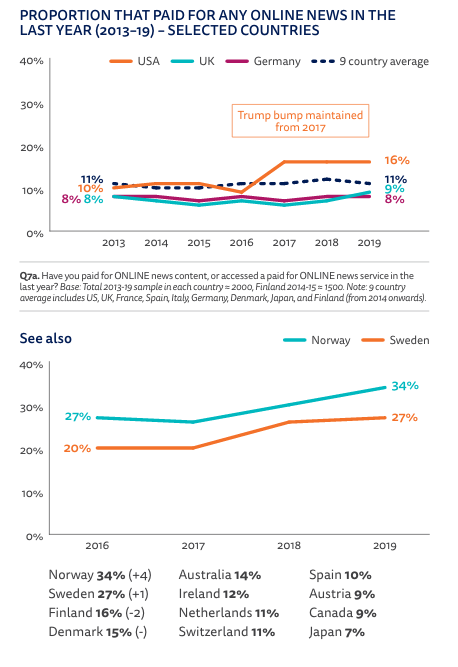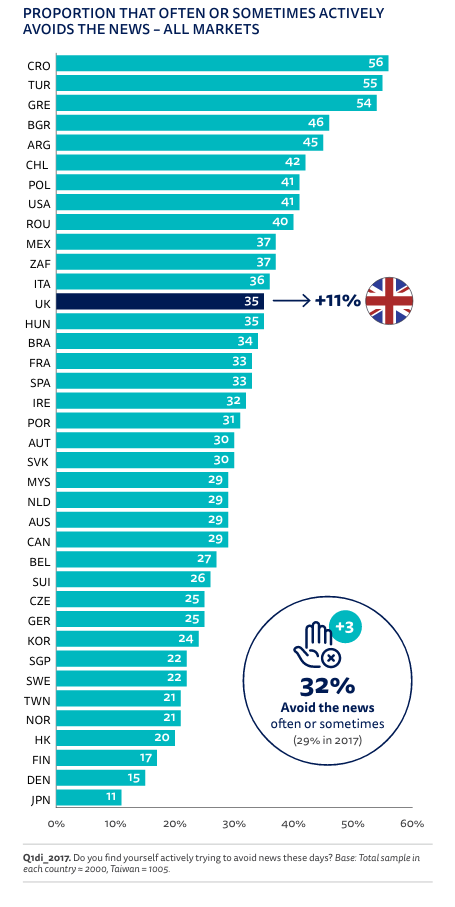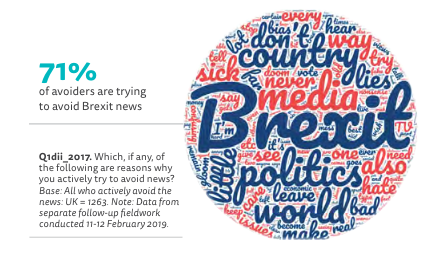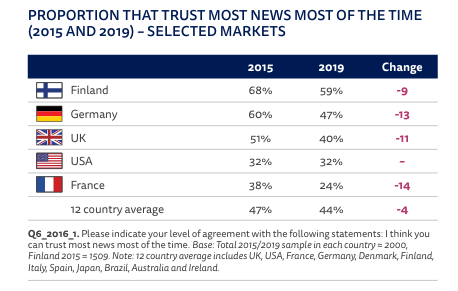
"One top line is the complexity of digital news," said Nic Newman, senior research associate, Reuters Institute for the Study of Journalism (RISJ), reflecting on the Reuters Institute Digital News Report 2019 published yesterday (12 June 2019).
Now in its eighth annual report, the study dissects the trends influencing news consumption habits of audiences in a rapidly-changing market across 38 countries spanning Europe, the Americas, Asia and Africa.
"News organisations are going through this redefinition of recognising how important the values and distinctiveness of their propositions are," Newman added.
"They are thinking a lot about that because as they look to charge for content, they need to make sure those values are expressed in a way that is truly useful for people.
"That’s a massive change from where we were when it was just competition, clickbait and trying to be the first to things. We’ve really seen that switch over the last few years, even going for advertising models it is the same process. Premium models are still about habits, but just a different model."
Pivot to paid
Amongst its key findings is the small increase seen by audiences who are prepared to pay for online news, building on other recent RISJ research. However, growth is still focused on a few big countries and well-known brands.
The UK sits at 9 per cent of paying news audiences, representing just 1 per cent growth since 2013, while the US remains strong from 2016 Trump Bump. It saw paying audiences jump from 9 per cent to 16 per cent in 2017, and it has remained at that figure since.
The average across the nine larger countries (US, UK, France, Spain, Italy, Germany, Denmark, Japan and Finland) remains at 11 per cent with little movement. Nordic countries lead the study at 23 per cent of paying subscribers on average, with frontrunner Norway at 24 per cent.

It means that, generally speaking, audiences are not yet ready to make the step from free to paid-for content. The other catch is that where this growth has happened, this has been predominantly seen in large publishers, leading to a ‘winner takes all’ dynamic. For all US digital-only subscriptions, half of those went to the New York Times, the Wall Street Journal and the Washington Post.
The benchmarks set by the likes of Netflix, Spotify and Amazon Prime are also seen as barriers, as audiences would prioritise online video services (47 per cent) and online music (15 per cent) over online news (7 per cent) if given the choice of the three. The friction of paywalls is also cited as key obstacle, with qualitative data reflecting strong preference for flexible or voluntary models.
There is a clue in the name as to why, according to Katie Vannneck-Smith, co-founder of Tortoise, speaking on the panel.
"When we put up ‘paywalls’, we called them that," she said. "You don’t hear Netflix or Spotify talking about walls, let’s talk up our industry. What we do is amazing and is the lifeblood of democracy."
Pivot to positivity
The slow media startup Tortoise is one of the best examples of a fresh approach to news, having been successfully crowdfunded by November 2018 on the promise of cutting through the noise of breaking news.

News avoidance is a real problem, with 32 per cent of overall audiences switching off - a figure up 3 per cent from last year. Why? In the UK - where news avoidance is 35 per cent - the answer is obvious. Brexit is to blame for two thirds of news avoidance, with 58 per cent of audiences saying the news as a whole is too depressing, and 40 per cent feeling unable to have an impact.

This is precisely why Tortoise arranges 'Think Ins' as part of their membership - around-the-room style conversations which foster conversations and tackle prominent issues, and to show the transparency of their work. For similar reasons, The Huffington Post opened up their newsroom for a week in Birmingham.
"What we hear a lot in Think Ins is not that people don’t want to hear about Brexit, what they want is to move on. It’s the lack of positivity, although that can be hard when you don't know where you're going, there is an element that people are desperately crying out for optimism," added Vanneck-Smith.
Huffington Post executive editor Jess Brammar recalled a conversation with an 18-year-old BBC apprentice to welcome a different approach to Brexit coverage.
"They told me that watching Brexit coverage is like coming in at season seven episode three of a series they haven’t watched. I find you can never explain enough, there’s so much assumed knowledge," she explained.
Pivot to pedigree
The result of news avoidance is an overall 2 per cent dip in trust in the news. The UK fell from 51 per cent in 2015, to 40 per cent in 2019.

There are other factors in the trust equation, most notably mis- and disinformation, with 55 per cent of audiences from 38 sampled countries concerned about the blurring of fact and fiction.
The highest jump in the study was felt in the UK, experiencing a 12 per cent increase, with 70 per cent of audiences now worried about the trustworthiness of news.
If there is one silver lining, however, it is that audiences are instead turning to 'reputable news sources' as a result of increased media literacy derived from their doubts around trustworthiness.
"There is growing awareness that there are some issues, but there is also scepticism," said Anna Bateson, chief customer officer, The Guardian.
"When people encounter information, they don’t just immediately believe it and so there is some sense they taking steps to validate or fact-check it," she added.
This is reflected in the 26 per cent of audiences that seek out 'reputable brands' for quality information, 24 per cent of audiences leaving less accurate sources, and 29 per cent opting against sharing information they were unsure about. Significantly in the US, 41 per cent of audiences are verifying information by checking multiple sources first.
Pivot to private
For both news consumption and general usage, Facebook remains on top of the social media food chain despite flat progress and controversy around its stance on fake news.
What is more, Facebook-owned products Facebook Messenger, WhatsApp and Instagram account for 84 per cent of weekly use for any purpose and 57 per cent of weekly use for news, and as such are channels that publishers are looking to capitalise on and convert social media users to news consumers.
"Having great content is not enough, it needs to be timed and discovered in the moment," said Naja Nielsen, digital director, BBC News. "We are also in the midst of big developments."
But WhatsApp in particular is also a hotbed for mis- and disinformation to spread, and some publishers are looking to penetrate that platform to both fight inaccurate information and find new audiences.
"People are moving to private networks, but it’s difficult for news organisations to find people there and there is not much control over what is shared. The problem is how to connect with people in this space, where they increasingly discuss and share news without being intrusive because people are not there to talk to brands," said Antonis Kalogeropoulos, research fellow, RISJ.
"It’s more intimate for speaking between people, but the power is more pronounced on the user side, unlike on Facebook or Twitter, for example."
WhatsApp is subject to huge demographic differences, though. An average of 16 per cent of audiences use it as a news source weekly; this is as low as 4 per cent in the US, and as high as a 53 per cent in Brazil. Huffington Post is active in that market, and Brammar had mixed feelings about the platform's potential.
"There’s opportunity in that publishers are forced to produce content that audiences love so much they will share with their family and friends. The downside is that the easiest way to do that is to not care about journalistic integrity, and clearly that dark social is really hard for us to track and it's easy for misinformation to spread," said Brammar.
Bateson added that young audiences are discovering news on Instagram and YouTube, and encouraged editors to look to new platforms to understand how news content is being redefined.
"It's about finding the right ways to deliver the important messages, insights an explanations of the world, in a trustworthy way on a platform where they are spending the most time," she said.
Pivot to podcasts
This generational difference can also be felt in podcasts, as Vanneck-Smith received a revelation from a young Tortoise member at one of its Think Ins on the future of audio.
"She was explaining she could not have a moment in her day where there wasn’t something laying in her ears. She felt like she was wasting her time unless she was learning something or happening at the same time. It’s definitely a generational thing," Vanneck-Smith said.
As podcasts continue to rise in popularity, Nielsen said there is no use in creating podcasts which appeal to old standards.
"I asked [my young reporters] to create news features that they would consume but they couldn’t come up with anything. They were journalists but they were trying to replicate us because they wanted the career. They would not consume it but at the end of the day they produced good podcasts," she said.
What next?
"One of the things I’ve changed my views on is that I used to think digital was the answer to everything," said Newman.
"What I’ve realised is that it’s about combining what digital is great for, which is reaching people with immediacy and relevance, with time-based products where you can build deeper engagement.
"That will be a big trend for the next few years, how do you combine podcasts with live events, rather than trying to squeeze everything into digital. The problem about digital is attention, people are not going to spend huge amounts of time on digital. It’s great for some things, so if you want a lasting relationship, you have to combine it with other products."
Free daily newsletter
If you like our news and feature articles, you can sign up to receive our free daily (Mon-Fri) email newsletter (mobile friendly).
Related articles
- 13 ideas for fresh news formats
- RISJ Digital News Report 2024: User needs with Vogue and The Conversation
- Video meets podcast: Five tips for making a successful 'vodcast'
- RISJ Digital News Report 2024: Three essential points for your newsroom
- RISJ Digital News Report 2024: Five trends to watch in the UK









